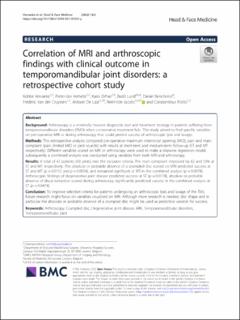| dc.contributor.author | Vervaeke, Kobbe | |
| dc.contributor.author | Verhelst, Pieter-Jan | |
| dc.contributor.author | Orhan, Kaan | |
| dc.contributor.author | Lund, Bodil Kristina | |
| dc.contributor.author | Benchimol, Daniel | |
| dc.contributor.author | Van der Cruyssen, Fréderic | |
| dc.contributor.author | De Laat, Antoon | |
| dc.contributor.author | Jacobs, Reinhilde | |
| dc.contributor.author | Politis, Constantinus | |
| dc.date.accessioned | 2023-01-18T14:57:20Z | |
| dc.date.available | 2023-01-18T14:57:20Z | |
| dc.date.created | 2022-05-10T12:43:26Z | |
| dc.date.issued | 2022 | |
| dc.identifier.issn | 1746-160X | |
| dc.identifier.uri | https://hdl.handle.net/11250/3044411 | |
| dc.description.abstract | Background: Arthroscopy is a minimally invasive diagnostic tool and treatment strategy in patients suffering from temporomandibular disorders (TMD) when conservative treatment fails. This study aimed to find specific variables on pre-operative MRI or during arthroscopy that could predict success of arthroscopic lysis and lavage.
Methods: This retrospective analysis compared pre-operative maximum interincisal opening (MIO), pain and main complaint (pain, limited MIO or joint sounds) with results at short-term and medium-term follow-up (ST and MT respectively). Different variables scored on MRI or arthroscopy were used to make a stepwise regression model, subsequently a combined analysis was conducted using variables from both MRI and arthroscopy.
Results: A total of 47 patients (50 joints) met the inclusion criteria. The main complaint improved by 62 and 53% at ST and MT respectively. The absolute or probable absence of a crumpled disc scored on MRI predicted success at ST and MT (p = 0.0112 and p = 0.0054), and remained significant at MT in the combined analysis (p = 0.0078). Arthroscopic findings of degenerative joint disease predicted success at ST (p = 0.0178), absolute or probable absence of discal reduction scored during arthroscopy significantly predicted success in the combined analysis at ST (p = 0.0474).
Conclusion: To improve selection criteria for patients undergoing an arthroscopic lysis and lavage of the TMJ, future research might focus on variables visualized on MRI. Although more research is needed, disc shape and in particular the absolute or probable absence of a crumpled disc might be used as predictive variable for success. | en_US |
| dc.language.iso | eng | en_US |
| dc.publisher | BMC | en_US |
| dc.rights | Navngivelse 4.0 Internasjonal | * |
| dc.rights.uri | http://creativecommons.org/licenses/by/4.0/deed.no | * |
| dc.title | Correlation of MRI and arthroscopic findings with clinical outcome in temporomandibular joint disorders: a retrospective cohort study | en_US |
| dc.type | Journal article | en_US |
| dc.type | Peer reviewed | en_US |
| dc.description.version | publishedVersion | en_US |
| dc.rights.holder | Copyright 2022 the authors | en_US |
| dc.source.articlenumber | 2 | en_US |
| cristin.ispublished | true | |
| cristin.fulltext | original | |
| cristin.qualitycode | 1 | |
| dc.identifier.doi | 10.1186/s13005-021-00305-y | |
| dc.identifier.cristin | 2023083 | |
| dc.source.journal | Head & Face Medicine | en_US |
| dc.identifier.citation | Head & Face Medicine. 2022, 18, 2. | en_US |
| dc.source.volume | 18 | en_US |

